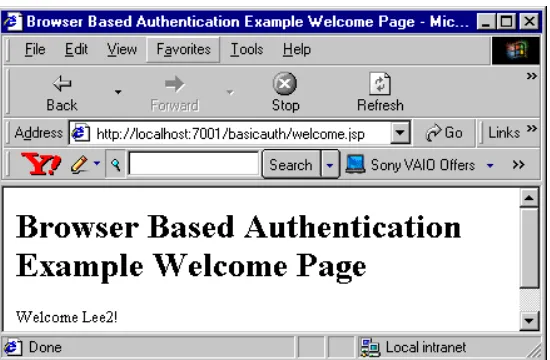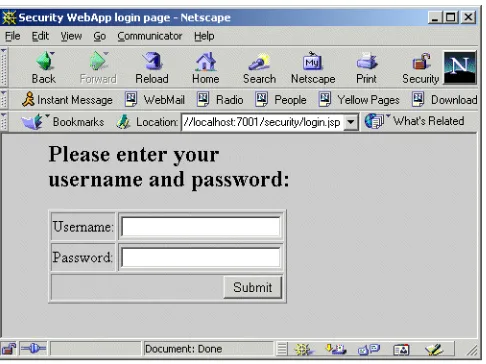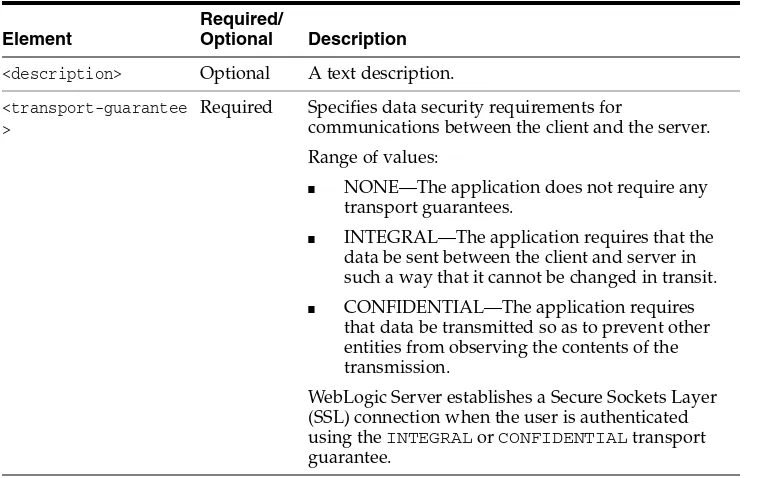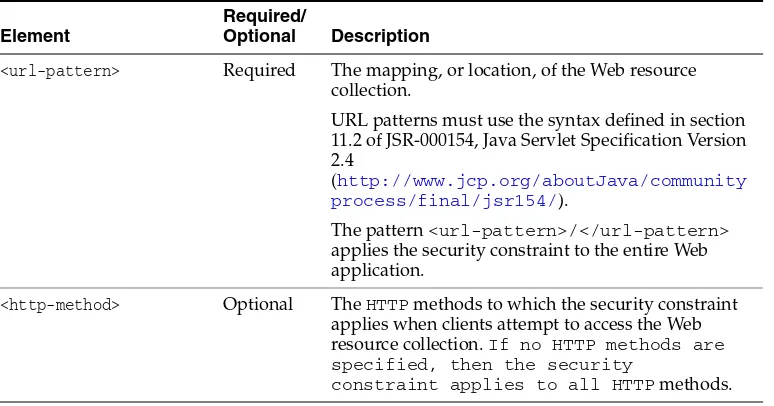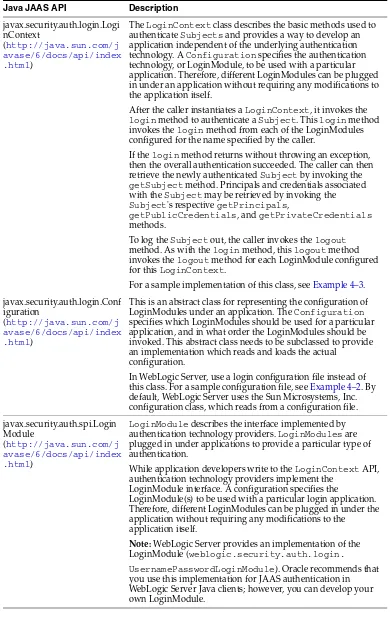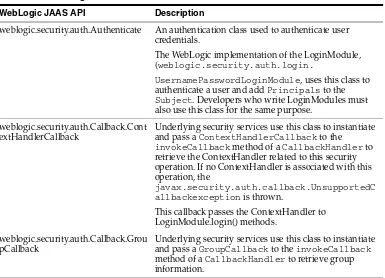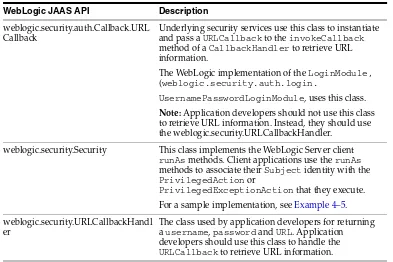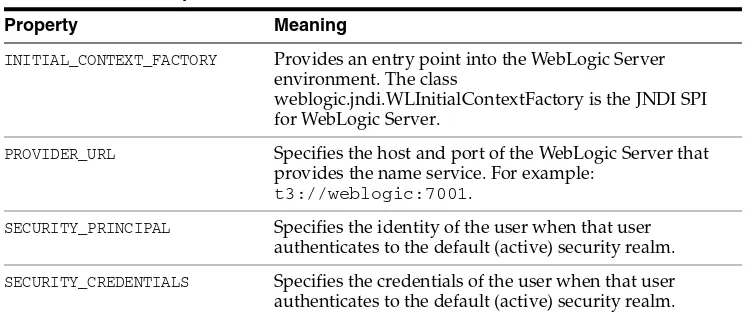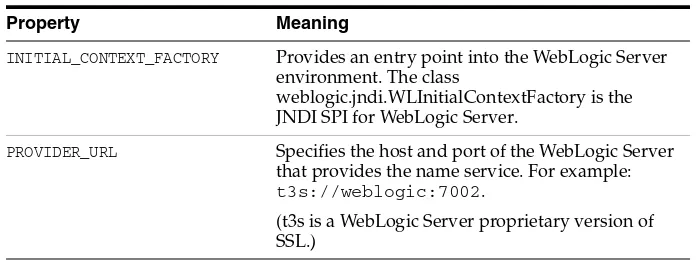Oracle® Fusion Middleware
Programming Security for Oracle WebLogic Server
11
g
Release 1 (10.3.5)
E13711-04
April 2011
Copyright © 2007, 2011, Oracle and/or its affiliates. All rights reserved.
This software and related documentation are provided under a license agreement containing restrictions on use and disclosure and are protected by intellectual property laws. Except as expressly permitted in your license agreement or allowed by law, you may not use, copy, reproduce, translate, broadcast, modify, license, transmit, distribute, exhibit, perform, publish, or display any part, in any form, or by any means. Reverse engineering, disassembly, or decompilation of this software, unless required by law for interoperability, is prohibited.
The information contained herein is subject to change without notice and is not warranted to be error-free. If you find any errors, please report them to us in writing.
If this software or related documentation is delivered to the U.S. Government or anyone licensing it on behalf of the U.S. Government, the following notice is applicable:
U.S. GOVERNMENT RIGHTS Programs, software, databases, and related documentation and technical data delivered to U.S. Government customers are "commercial computer software" or "commercial technical data" pursuant to the applicable Federal Acquisition Regulation and agency-specific supplemental regulations. As such, the use, duplication, disclosure, modification, and adaptation shall be subject to the restrictions and license terms set forth in the applicable Government contract, and, to the extent applicable by the terms of the Government contract, the additional rights set forth in FAR 52.227-19, Commercial Computer Software License (December 2007). Oracle USA, Inc., 500 Oracle Parkway, Redwood City, CA 94065.
This software is developed for general use in a variety of information management applications. It is not developed or intended for use in any inherently dangerous applications, including applications which may create a risk of personal injury. If you use this software in dangerous applications, then you shall be responsible to take all appropriate fail-safe, backup, redundancy, and other measures to ensure the safe use of this software. Oracle Corporation and its affiliates disclaim any liability for any damages caused by use of this software in dangerous applications.
Oracle is a registered trademark of Oracle Corporation and/or its affiliates. Other names may be trademarks of their respective owners.
Contents
Preface
... xiDocumentation Accessibility ... xi
Conventions ... xi
1
Introduction and Roadmap
1.1 Document Scope... 1-1 1.2 Audience for This Guide... 1-1 1.3 Guide to this Document ... 1-2 1.4 Related Information... 1-3 1.5 Security Samples and Tutorials ... 1-3 1.5.1 Security Examples in the WebLogic Server Distribution... 1-4 1.6 New and Changed Security Features in This Release ... 1-4
2
WebLogic Security Programming Overview
2.1 What Is Security?... 2-1 2.2 Administration Console and Security... 2-2 2.3 Types of Security Supported by WebLogic Server ... 2-2 2.3.1 Authentication... 2-2 2.3.2 Authorization ... 2-2 2.3.3 Java EE Security ... 2-3 2.4 Security APIs ... 2-3 2.4.1 JAAS Client Application APIs ... 2-3 2.4.1.1 Java JAAS Client Application APIs... 2-3 2.4.1.2 WebLogic JAAS Client Application APIs ... 2-4 2.4.2 SSL Client Application APIs ... 2-4 2.4.2.1 Java SSL Client Application APIs... 2-4 2.4.2.2 WebLogic SSL Client Application APIs ... 2-4 2.4.3 Other APIs ... 2-5
3
Securing Web Applications
3.6 Using Programmatic Security With Web Applications... 3-28 3.6.1 getUserPrincipal... 3-28 3.6.2 isUserInRole ... 3-29 3.7 Using the Programmatic Authentication API... 3-30 3.7.1 Change the User’s Session ID at Login... 3-31
4
Using JAAS Authentication in Java Clients
4.1 JAAS and WebLogic Server... 4-1 4.2 JAAS Authentication Development Environment... 4-2 4.2.1 JAAS Authentication APIs ... 4-3 4.2.2 JAAS Client Application Components ... 4-6 4.2.3 WebLogic LoginModule Implementation... 4-7 4.2.4 JVM-Wide Default User and the runAs() Method... 4-8 4.3 Writing a Client Application Using JAAS Authentication ... 4-8 4.4 Using JNDI Authentication ... 4-12 4.5 Java Client JAAS Authentication Code Examples ... 4-13
5
Using SSL Authentication in Java Clients
5.1 JSSE and WebLogic Server ... 5-1 5.2 Using JNDI Authentication ... 5-2 5.3 SSL Certificate Authentication Development Environment... 5-3 5.3.1 SSL Authentication APIs ... 5-3 5.3.2 SSL Client Application Components ... 5-7 5.4 Writing Applications that Use SSL... 5-8 5.4.1 Communicating Securely From WebLogic Server to Other WebLogic Servers... 5-8 5.4.2 Writing SSL Clients ... 5-9 5.4.2.1 SSLClient Sample... 5-9 5.4.2.2 SSLSocketClient Sample ... 5-10 5.4.3 Using Two-Way SSL Authentication ... 5-11 5.4.3.1 Two-Way SSL Authentication with JNDI ... 5-11 5.4.3.2 Writing a User Name Mapper ... 5-14 5.4.3.3 Using Two-Way SSL Authentication Between WebLogic Server Instances... 5-15 5.4.3.4 Using Two-Way SSL Authentication with Servlets... 5-16 5.4.4 Using a Custom Hostname Verifier ... 5-16 5.4.5 Using a Trust Manager ... 5-18 5.4.6 Using the CertPath Trust Manager ... 5-19 5.4.7 Using a Handshake Completed Listener ... 5-19 5.4.8 Using an SSLContext... 5-20 5.4.9 Using URLs to Make Outbound SSL Connections ... 5-21 5.5 SSL Client Code Examples... 5-23
6
Securing Enterprise JavaBeans (EJBs)
6.3.2.8.1 Used Within ... 6-14 6.3.2.8.2 Example ... 6-14 6.3.2.9 role-name ... 6-15 6.3.2.9.1 Used Within ... 6-15 6.3.2.9.2 Example ... 6-15 6.3.2.10 run-as-identity-principal ... 6-15 6.3.2.10.1 Used Within ... 6-15 6.3.2.10.2 Example ... 6-15 6.3.2.11 run-as-principal-name ... 6-16 6.3.2.11.1 Used Within ... 6-16 6.3.2.11.2 Example ... 6-16 6.3.2.12 run-as-role-assignment ... 6-16 6.3.2.12.1 Example ... 6-16 6.3.2.13 security-permission ... 6-18 6.3.2.13.1 Example ... 6-18 6.3.2.14 security-permission-spec... 6-18 6.3.2.14.1 Used Within ... 6-18 6.3.2.14.2 Example ... 6-18 6.3.2.15 security-role-assignment ... 6-19 6.3.2.15.1 Example ... 6-19 6.3.2.16 transport-requirements... 6-19 6.3.2.16.1 Used Within ... 6-19 6.3.2.16.2 Example ... 6-19 6.4 Using Programmatic Security With EJBs ... 6-20 6.4.1 getCallerPrincipal ... 6-20 6.4.2 isCallerInRole ... 6-20
7
Using Network Connection Filters
7.1 The Benefits of Using Network Connection Filters ... 7-1 7.2 Network Connection Filter API ... 7-1 7.2.1 Connection Filter Interfaces ... 7-2 7.2.1.1 ConnectionFilter Interface... 7-2 7.2.1.2 ConnectionFilterRulesListener Interface... 7-2 7.2.2 Connection Filter Classes... 7-2 7.2.2.1 ConnectionFilterImpl Class... 7-3 7.2.2.2 ConnectionEvent Class ... 7-3 7.3 Guidelines for Writing Connection Filter Rules... 7-3 7.3.1 Connection Filter Rules Syntax... 7-3 7.3.2 Types of Connection Filter Rules ... 7-4 7.3.3 How Connection Filter Rules are Evaluated ... 7-5 7.4 Configuring the WebLogic Connection Filter... 7-5 7.5 Developing Custom Connection Filters ... 7-5
8
Using Java Security to Protect WebLogic Resources
8.2.1.2 Setting Application-Type Security Policies ... 8-4 8.2.1.3 Setting Application-Specific Security Policies... 8-4 8.2.2 Using Printing Security Manager ... 8-5 8.2.2.1 Printing Security Manager Startup Arguments ... 8-5 8.2.2.2 Starting WebLogic Server With Printing Security Manager ... 8-6 8.2.2.3 Writing Output Files ... 8-6 8.2.3 Using the Java Authorization Contract for Containers... 8-7 8.2.3.1 Comparing the WebLogic JACC Provider with the WebLogic
Authentication Provider... 8-8 8.2.3.2 Enabling the WebLogic JACC Provider ... 8-8
9
SAML APIs
9.1 SAML API Description... 9-2 9.2 Custom POST Form Parameter Names ... 9-4 9.3 Creating Assertions for Non-WebLogic SAML 1.1 Relying Parties ... 9-5 9.3.1 Overview of Creating a Custom SAML Name Mapper... 9-5 9.3.2 Do You Need Multiple SAMLCredentialAttributeMapper Implementations? ... 9-6 9.3.3 Classes, Interfaces, and Methods... 9-6 9.3.3.1 SAMLAttributeStatementInfo Class ... 9-6 9.3.3.1.1 SAMLAttributeInfo Class... 9-7 9.3.3.2 SAMLCredentialAttributeMapper Interface ... 9-9 9.3.3.2.1 New Methods for SAMLNameMapperInfo Class... 9-10 9.3.4 Example Custom SAMLCredentialAttributeMapper Class ... 9-11 9.3.5 Make the Custom SAMLCredentialAttributeMapper Class Available in the
Console ... 9-14 9.4 Configuring SAML SSO Attribute Support ... 9-15 9.4.1 What Are SAML SSO Attributes? ... 9-15 9.4.2 New API’s for SAML Attributes ... 9-16 9.4.3 SAML 2.0 Basic Attribute Profile Required ... 9-16 9.4.4 Passing Multiple Attributes to SAML Credential Mappers ... 9-16 9.4.5 How to Implement SAML Attributes ... 9-17 9.4.6 Examples of the SAML 2.0 Attribute Interfaces ... 9-19 9.4.6.1 Example Custom SAML 2.0 Credential Attribute Mapper ... 9-19 9.4.6.2 Custom SAML 2.0 Identity Asserter Attribute Mapper ... 9-21 9.4.7 Examples of the SAML 1.1 Attribute Interfaces ... 9-23 9.4.7.1 Example Custom SAML 1.1 Credential Attribute Mapper ... 9-23 9.4.7.2 Custom SAML 1.1 Identity Asserter Attribute Mapper ... 9-25 9.4.8 Make the Custom SAML Credential Attribute Mapper Class Available in the
Console ... 9-26 9.4.9 Make the Custom SAML Identity Asserter Class Available in the Console... 9-27
10
Using CertPath Building and Validation
10.1.3 Use the JDK CertPathBuilder Interface ... 10-3 10.1.4 Example Code Flow for Looking Up a Certificate Chain ... 10-4 10.2 CertPath Validation ... 10-4 10.2.1 Instantiate a CertPathValidatorParameters ... 10-4 10.2.2 Use the JDK CertPathValidator Interface... 10-5 10.2.3 Example Code Flow for Validating a Certificate Chain... 10-6
Preface
This preface describes the document accessibility features and conventions used in this guide—Programming Security for Oracle WebLogic Server.
Documentation Accessibility
Our goal is to make Oracle products, services, and supporting documentation accessible to all users, including users that are disabled. To that end, our
documentation includes features that make information available to users of assistive technology. This documentation is available in HTML format, and contains markup to facilitate access by the disabled community. Accessibility standards will continue to evolve over time, and Oracle is actively engaged with other market-leading
technology vendors to address technical obstacles so that our documentation can be accessible to all of our customers. For more information, visit the Oracle Accessibility Program Web site at http://www.oracle.com/accessibility/.
Accessibility of Code Examples in Documentation
Screen readers may not always correctly read the code examples in this document. The conventions for writing code require that closing braces should appear on an
otherwise empty line; however, some screen readers may not always read a line of text that consists solely of a bracket or brace.
Accessibility of Links to External Web Sites in Documentation
This documentation may contain links to Web sites of other companies or
organizations that Oracle does not own or control. Oracle neither evaluates nor makes any representations regarding the accessibility of these Web sites.
Access to Oracle Support
Oracle customers have access to electronic support through My Oracle Support. For information, visit http://www.oracle.com/support/contact.html or visit
http://www.oracle.com/accessibility/support.html if you are hearing impaired.
Conventions
The following text conventions are used in this document:
Convention Meaning
which you supply particular values.
1
1
Introduction and Roadmap
The following sections describe the contents and organization of this guide—Programming WebLogic Security:
■ Section 1.1, "Document Scope"
■ Section 1.2, "Audience for This Guide"
■ Section 1.3, "Guide to this Document"
■ Section 1.4, "Related Information"
■ Section 1.5, "Security Samples and Tutorials"
■ Section 1.6, "New and Changed Security Features in This Release"
1.1 Document Scope
This document explains how to use the WebLogic Server security programming features.
See Section 1.4, "Related Information" for a description of other WebLogic Server security documentation.
1.2 Audience for This Guide
This document is intended for the following audiences:
■ Application Developers
Java programmers who focus on developing client applications, adding security to Web applications and Enterprise JavaBeans (EJBs). They work with other
engineering, Quality Assurance (QA), and database teams to implement security features. Application developers have in-depth/working knowledge of Java (including Java Platform, Enterprise Edition (Java EE) Version 5 components such as servlets/JSPs and JSEE) and Java security.
Application developers use the WebLogic security and Java 2 security application programming interfaces (APIs) to secure their applications. Therefore, this document provides instructions for using those APIs for securing Web applications, Java applications, and Enterprise JavaBeans (EJBs).
■ Security Developers
design and that no security holes are introduced. They also work with WebLogic Server administrators to ensure that security is properly configured. Security developers have a solid understanding of security concepts, including authentication, authorization, auditing (AAA), in-depth knowledge of Java (including Java Management eXtensions (JMX), and working knowledge of WebLogic Server and security provider functionality.
Security developers use the Security Service Provider Interfaces (SSPIs) to develop custom security providers for use with WebLogic Server. This document does not address this task; for information on how to use the SSPIs to develop custom security providers, see Developing Security Providers for Oracle WebLogic Server
■ Server Administrators
Administrators who work closely with application architects to design a security scheme for the server and the applications running on the server, to identify potential security risks, and to propose configurations that prevent security problems. Related responsibilities may include maintaining critical production systems, configuring and managing security realms, implementing authentication and authorization schemes for server and application resources, upgrading security features, and maintaining security provider databases. WebLogic Server administrators have in-depth knowledge of the Java security architecture, including Web application and EJB security, Public Key security, and SSL.
■ Application Administrators
Administrators who work with WebLogic Server administrators to implement and maintain security configurations and authentication and authorization schemes, and to set up and maintain access to deployed application resources in defined security realms. Application administrators have general knowledge of security concepts and the Java Security architecture. They understand Java, XML,
deployment descriptors, and can identify security events in server and audit logs. While administrators typically use the Administration Console to deploy,
configure, and manage applications when they put the applications into production, application developers may also use the Administration Console to test their applications before they are put into production. At a minimum, testing requires that applications be deployed and configured. This document does not cover some aspects of administration as it relates to security, rather, it references Securing Oracle WebLogic Server, Securing Resources Using Roles and Policies for Oracle WebLogic Server, and Oracle WebLogic Server Administration Console Help for
descriptions of how to use the Administration Console to perform security tasks.
1.3 Guide to this Document
This document is organized as follows:
■ Chapter 2, "WebLogic Security Programming Overview" discusses the need for
security, and the WebLogic Security application programming Interfaces (APIs).
■ Chapter 3, "Securing Web Applications" describes how to implement security in
Web applications.
■ Chapter 4, "Using JAAS Authentication in Java Clients" describes how to
implement JAAS authentication in Java clients.
■ Chapter 5, "Using SSL Authentication in Java Clients" describes how to implement
Security Samples and Tutorials
■ Chapter 6, "Securing Enterprise JavaBeans (EJBs)" describes how to implement
security in Enterprise JavaBeans.
■ Chapter 7, "Using Network Connection Filters"describes how to implement
network connection filters.
■ Chapter 8, "Using Java Security to Protect WebLogic Resources"discusses using
Java security to protect WebLogic resources.
■ Chapter 9, "SAML APIs" describes the WebLogic SAML APIs.
■ Chapter 10, "Using CertPath Building and Validation" describes how to build and
validate certification paths.
■ Appendix A, "Deprecated Security APIs" provides a list of weblogic.security
packages in which APIs have been deprecated.
1.4 Related Information
In addition to this document, Programming WebLogic Security, the following documents provide information on the WebLogic Security Service:
■ Understanding Security for Oracle WebLogic Server—This document summarizes
the features of the WebLogic Security Service and presents an overview of the architecture and capabilities of the WebLogic Security Service. It is the starting point for understanding the WebLogic Security Service.
■ Securing a Production Environment for Oracle WebLogic Server— This document
highlights essential security measures for you to consider before you deploy WebLogic Server into a production environment.
■ Developing Security Providers for Oracle WebLogic Server—This document provides
security vendors and application developers with the information needed to develop custom security providers that can be used with WebLogic Server.
■ Securing Oracle WebLogic Server—This document explains how to configure
security for WebLogic Server and how to use Compatibility security.
■ Securing Resources Using Roles and Policies for Oracle WebLogic Server—This
document introduces the various types of WebLogic resources, and provides information that allows you to secure these resources using WebLogic Server.
■ Oracle WebLogic Server Administration Console Help—This document describes how
to use the Administration Console to perform security tasks.
■ Javadocs for WebLogic Classes—This document includes reference documentation
for the WebLogic security packages that are provided with and supported by the WebLogic Server software.
1.5 Security Samples and Tutorials
In addition to the documents listed in Section 1.4, "Related Information", Oracle provides a variety of code samples for developers.
1.5.1 Security Examples in the WebLogic Server Distribution
WebLogic Server optionally installs API code examples in WL_
HOME\samples\server\examples\src\examples\security, where WL_HOME
is the top-level directory of your WebLogic Server installation. You can start the examples server, and obtain information about the samples and how to run them from the WebLogic Server Start menu.
The following examples illustrate WebLogic security features:
■ Java Authentication and Authorization Service ■ Outbound and Two-way SSL
The security tasks and code examples provided in this document assume that you are using the WebLogic security providers that are included in the WebLogic Server distribution, not custom security providers. The usage of the WebLogic security APIs does not change if you elect to use custom security providers, however, the
management procedures of your custom security providers may be different.
1.6 New and Changed Security Features in This Release
For a comprehensive listing of the new WebLogic Server features introduced in this release, see What's New in Oracle WebLogic Server.
Note: This document does not provide comprehensive instructions on how to configure WebLogic Security providers or custom security providers. For information on configuring WebLogic security
2
2
WebLogic Security Programming Overview
The following topics are covered in this section:
■ Section 2.1, "What Is Security?"
■ Section 2.2, "Administration Console and Security"
■ Section 2.3, "Types of Security Supported by WebLogic Server"
■ Section 2.4, "Security APIs"
2.1 What Is Security?
Security refers to techniques for ensuring that data stored in a computer or passed between computers is not compromised. Most security measures involve proof material and data encryption. Proof material is typically a secret word or phrase that gives a user access to a particular application or system. Data encryption is the
translation of data into a form that cannot be interpreted without holding or supplying the same secret.
Distributed applications, such as those used for electronic commerce (e-commerce), offer many access points at which malicious people can intercept data, disrupt operations, or generate fraudulent input. As a business becomes more distributed the probability of security breaches increases. Accordingly, as a business distributes its applications, it becomes increasingly important for the distributed computing software upon which such applications are built to provide security.
An application server resides in the sensitive layer between end users and your valuable data and resources. WebLogic Server provides authentication, authorization, and encryption services with which you can guard these resources. These services cannot provide protection, however, from an intruder who gains access by discovering and exploiting a weakness in your deployment environment.
Therefore, whether you deploy WebLogic Server on the Internet or on an intranet, it is a good idea to hire an independent security expert to go over your security plan and procedures, audit your installed systems, and recommend improvements.
available from the CERT™ Coordination Center operated by Carnegie Mellon University.
Oracle suggests that you apply the remedies recommended in our security advisories. In the event of a problem with an Oracle product, Oracle distributes an advisory and instructions with the appropriate course of action. If you are responsible for security related issues at your site, please register to receive future notifications.
2.2 Administration Console and Security
With regard to security, you can use the Administration Console to define and edit deployment descriptors for Web Applications, EJBs, Java EE Connectors, and Enterprise Applications. This document, Programming WebLogic Security, does not describe how to use the Administration Console to configure security. For information on how to use the Administration Console to define and edit deployment descriptors, see Securing Resources Using Roles and Policies for Oracle WebLogic Server and Securing Oracle WebLogic Server.
2.3 Types of Security Supported by WebLogic Server
WebLogic Server supports the following security mechanisms:
■ Section 2.3.1, "Authentication"
■ Section 2.3.2, "Authorization"
■ Section 2.3.3, "Java EE Security"
2.3.1 Authentication
Authentication is the mechanism by which callers and service providers prove that they are acting on behalf of specific users or systems. Authentication answers the question, "Who are you?" using credentials. When the proof is bidirectional, it is referred to as mutual authentication.
WebLogic Server supports username and password authentication and certificate authentication. For certificate authentication, WebLogic Server supports both one-way and two-way SSL (Secure Sockets Layer) authentication. Two-way SSL authentication is a form of mutual authentication.
In WebLogic Server, Authentication providers are used to prove the identity of users or system processes. Authentication providers also remember, transport, and make identity information available to various components of a system (via subjects) when needed. You can configure the Authentication providers using the Web application and EJB deployment descriptor files, or the Administration Console, or a combination of both.
2.3.2 Authorization
Authorization is the process whereby the interactions between users and WebLogic resources are controlled, based on user identity or other information. In other words, authorization answers the question, "What can you access?"
In WebLogic Server, a WebLogic Authorization provider is used to limit the
interactions between users and WebLogic resources to ensure integrity, confidentiality, and availability. You can configure the Authorization provider using the Web
Security APIs
WebLogic Server also supports the use of programmatic authorization (also referred to in this document as programmatic security) to limit the interactions between users and WebLogic resources.
2.3.3 Java EE Security
For implementation and use of user authentication and authorization, WebLogic Server utilizes the security services of the Java EE Development Kit 6.0 (JDK 6.0). Like the other Java EE components, the security services are based on standardized, modular components. WebLogic Server implements these Java security service methods according to the standard, and adds extensions that handle many details of application behavior automatically, without requiring additional programming.
2.4 Security APIs
This section lists the Security packages and classes that are implemented and
supported by WebLogic Server. You use these packages to secure interactions between WebLogic Server and client applications, Enterprise JavaBeans (EJBs), and Web applications.
The following topics are covered in this section:
■ Section 2.4.1, "JAAS Client Application APIs"
■ Section 2.4.2, "SSL Client Application APIs"
■ Section 2.4.3, "Other APIs"
2.4.1 JAAS Client Application APIs
You use Java APIs and WebLogic APIs to write client applications that use JAAS authentication.
The following topics are covered in this section:
■ Section 2.4.1.1, "Java JAAS Client Application APIs"
■ Section 2.4.1.2, "WebLogic JAAS Client Application APIs"
2.4.1.1 Java JAAS Client Application APIs
You use the following Java APIs to write JAAS client applications. The APIs are available at http://java.sun.com/javase/6/docs/api/index.html.
■ javax.naming ■ javax.security.auth
■ javax.security.auth.callback ■ javax.security.auth.login ■ javax.security.auth.spi
Note: Several of the WebLogic security packages, classes, and methods are deprecated in this release of WebLogic Server. For more detailed information on deprecated packages and classes, see
For information on how to use these APIs, see Section 4.2.1, "JAAS Authentication APIs".
2.4.1.2 WebLogic JAAS Client Application APIs
You use the following WebLogic APIs to write JAAS client applications:
■ weblogic.security ■ weblogic.security.auth
■ weblogic.security.auth.callback
For information on how to use these APIs, see Section 4.2.1, "JAAS Authentication APIs".
2.4.2 SSL Client Application APIs
You use Java and WebLogic APIs to write client applications that use SSL authentication:
The following topics are covered in this section:
■ Section 2.4.2.1, "Java SSL Client Application APIs"
■ Section 2.4.2.2, "WebLogic SSL Client Application APIs"
2.4.2.1 Java SSL Client Application APIs
You use the following Java APIs (available from
http://java.sun.com/javase/6/docs/api/index.html) to write SSL client applications:
■ java.security ■ java.security.cert ■ javax.crypto ■ javax.naming ■ javax.net ■ javax.security ■ javax.servlet ■ javax.servet.http
WebLogic Server also supports the javax.net.SSL API
(http://java.sun.com/javase/6/docs/api/index.html), but Oracle
recommends that you use the weblogic.security.SSL package when you use SSL with WebLogic Server.
For information on how to use these APIs, see Section 5.3.1, "SSL Authentication APIs".
2.4.2.2 WebLogic SSL Client Application APIs
You use the following WebLogic APIs to write SSL client applications.
■ weblogic.net.http ■ weblogic.security.SSL
Security APIs
2.4.3 Other APIs
Additionally, you use the following APIs to develop WebLogic Server applications:
■ weblogic.security.jacc
This API provides the RoleMapper interface. If you implement the Java
Authorization Contract for Containers (JACC), you can use this package with the javax.security.jacc package
(http://java.sun.com/javaee/5/docs/api/javax/security/jacc/pa ckage-summary.html). See Section 8.2.3, "Using the Java Authorization
Contract for Containers" for information about the WebLogic JACC provider. See
http://java.sun.com/j2ee/javaacc/ for information on developing a JACC provider.
■ weblogic.security.net
This API provides interfaces and classes that are used to implement network connection filters. Network connection filters allow or deny connections to
WebLogic Server based on attributes such as the IP address, domain, or protocol of the initiator of the network connection. For more information about how to use this API, see Chapter 7, "Using Network Connection Filters".
■ weblogic.security.pk
This API provides interfaces and classes to build and validate certification paths. See Chapter 10, "Using CertPath Building and Validation" for information on using this API to build and validate certificate chains.
See the java.security.cert package
(http://java.sun.com/javase/6/docs/api/java/security/cert/pac kage-summary.html) for additional information on certificates and certificate paths.
■ weblogic.security.providers.saml
This API provides interfaces and classes that are used to perform mapping of user and group information to Security Assertion Markup Language (SAML)
assertions, and to cache and retrieve SAML assertions.
SAML is an XML-based framework for exchanging security information.
WebLogic Server supports SAML V2.0 and V1.1, including the Browser/Post and Browser/Artifact profiles. SAML authorization is not supported.
For more information about SAML, see http://www.oasis-open.org.
■ weblogic.security.service
This API includes interfaces, classes, and exceptions that support security providers. The WebLogic Security Framework consists of interfaces, classes, and exceptions provided by this API. The interfaces, classes, and exceptions in this API should be used in conjunction with those in the weblogic.security.spi package. For more information about how to use this API, see Developing Security Providers for Oracle WebLogic Server.
■ weblogic.security.services
This API provides the server-side authentication class. This class is used to perform a local login to the server. It provides login methods that are used with CallbackHandlers to authenticate the user and return credentials using the default security realm.
This package provides the Security Service Provider Interfaces (SSPIs). It provides interfaces, classes, and exceptions that are used for developing custom security providers. In many cases, these interfaces, classes, and exceptions should be used in conjunction with those in the weblogic.security.service API. You implement interfaces, classes, and exceptions from this package to create runtime classes for security providers. For more information about how to use the SSPIs, see Developing Security Providers for Oracle WebLogic Server.
■ weblogic.servlet.security
This API provides a server-side API that supports programmatic authentication from within a servlet application. For more about how to use this API, see
3
3
Securing Web Applications
WebLogic Server supports the Java EE architecture security model for securing Web applications, which includes support for declarative authorization (also referred to in this document as declarative security) and programmatic authorization (also referred to in this document as programmatic security).
This section covers the following topics:
■ Section 3.1, "Authentication With Web Browsers"
■ Section 3.2, "Multiple Web Applications, Cookies, and Authentication"
■ Section 3.3, "Developing Secure Web Applications"
■ Section 3.4, "Using Declarative Security With Web Applications"
■ Section 3.5, "Web Application Security-Related Deployment Descriptors"
■ Section 3.6, "Using Programmatic Security With Web Applications"
■ Section 3.7, "Using the Programmatic Authentication API"
WebLogic Server supports the use of the HttpServletRequest.isUserInRole
and HttpServletRequest.getUserPrincipal methods and the use of the
security-role-ref element in deployment descriptors to implement programmatic authorization in Web applications.
3.1 Authentication With Web Browsers
Web browsers can connect to WebLogic Server over either a HyperText Transfer Protocol (HTTP) port or an HTTP with SSL (HTTPS) port. The benefits of using an HTTPS port versus an HTTP port are two-fold. With HTTPS connections:
■ All communication on the network between the Web browser and the server is
encrypted. None of the communication, including the user name and password, is in clear text.
■ As a minimum authentication requirement, the server is required to present a
digital certificate to the Web browser client to prove its identity.
Note: You can use deployment descriptor files and the
If the server is configured for two-way SSL authentication, both the server and client are required to present a digital certificate to each other to prove their identity.
3.1.1 User Name and Password Authentication
WebLogic Server performs user name and password authentication when users use a Web browser to connect to the server via the HTTP port. In this scenario, the browser and an instance of WebLogic Server interact in the following manner to authenticate a user (see Figure 3–1):
1. A user invokes a WebLogic resource in
WebLogic Server
by entering the URL for that resource in a Web browser. The HTTP URL contains the HTTP listen port, for example, http://myserver:7001.2. The Web server in WebLogic Server receives the request.
3. The Web server determines whether the WebLogic resource is protected by a security policy. If the WebLogic resource is protected, the Web server uses the established HTTP connection to request a user name and password from the user.
4. When the user's Web browser receives the request from the Web server, it prompts the user for a user name and password.
5. The Web browser sends the request to the Web server again, along with the user name and password.
6. The Web server forwards the request to the Web server plug-in. WebLogic Server provides the following plug-ins for Web servers:
■ Apache-WebLogic Server plug-in ■ Sun Java System Web Server plug-in ■ Internet Information Server (IIS) plug-in
The Web server plug-in performs authentication by sending the request, via the HTTP protocol, to WebLogic Server, along with the authentication data (user name and password) received from the user.
7. Upon successful authentication, WebLogic Server proceeds to determine whether the user is authorized to access the WebLogic resource.
8. Before invoking a method on the WebLogic resource, the WebLogic Server instance performs a security authorization check. During this check, the server security extracts the user's credentials from the security context, determines the user's security role, compares the user's security role to the security policy for the requested WebLogic resource, and verifies that the user is authorized to invoke the method on the WebLogic resource.
9. If authorization succeeds, the server fulfills the request.
Authentication With Web Browsers
Figure 3–1 Secure Login for Web Browsers
3.1.2 Digital Certificate Authentication
WebLogic Server uses encryption and digital certificate authentication when Web browser users connect to the server via the HTTPS port. In this scenario, the browser and WebLogic Server instance interact in the following manner to authenticate and authorize a user (see Figure 3–1):
1. A user invokes a WebLogic resource in
WebLogic Server
by entering the URL for that resource in a Web browser. The HTTPS URL contains the SSL listen port, for example, https://myserver:7002.2. The Web server in WebLogic Server receives the request.
3. The Web server checks whether the WebLogic resource is protected by a security policy. If the WebLogic resource is protected, the Web server uses the established HTTPS connection to request a user name and password from the user.
4. When the user's Web browser receives the request from WebLogic Server, it prompts the user for a user name and password. (This step is optional.)
5. The Web browser sends the request again, along with the user name and password. (Only supplied if requested by the server.)
6. WebLogic Server presents its digital certificate to the Web browser.
7. The Web browser checks that the server's name used in the URL (for example, myserver) matches the name in the digital certificate and that the digital certificate was issued by a trusted third party, that is, a trusted CA
8. If two-way SSL authentication is in force on the server, the server requests a digital certificate from the client.
9. The Web server forwards the request to the Web server plug-in. If secure proxy is set (this is the case if the HTTPS protocol is being used), the Web server plug-in also performs authentication by sending the request, via the HTTPS protocol, to the WebLogic resource in WebLogic Server, along with the authentication data (user name and password) received from the user.
10. Upon successful authentication, WebLogic Server proceeds to determine whether the user is authorized to access the WebLogic resource.
11. Before invoking a method on the WebLogic resource, the server performs a security authorization check. During this check, the server extracts the user's credentials from the security context, determines the user's security role, compares the user's security role to the security policy for the requested WebLogic resource, and verifies that the user is authorized to invoke the method on the WebLogic resource.
12. If authorization succeeds, the server fulfills the request. For more information, see the following documents:
■ Securing Oracle WebLogic Server
■ Installing and Configuring the Apache HTTP Server Plug-In ■ Installing and Configuring the Microsoft IIS Plug-In
3.2 Multiple Web Applications, Cookies, and Authentication
By default, WebLogic Server assigns the same cookie name (JSESSIONID) to all Web applications. When you use any type of authentication, all Web applications that use the same cookie name use a single sign-on for authentication. Once a user is
authenticated, that authentication is valid for requests to any Web Application that uses the same cookie name. The user is not prompted again for authentication.
Note: Even though WebLogic Server cannot be configured to enforce the full two-way SSL handshake with 1.0 Web Server proxy plug-ins, proxy plug-ins can be configured to provide the client certificate to the server if it is needed. To do this, configure the proxy plug-in to export the client certificate in the HTTP Header for WebLogic Server. For instructions on how to configure proxy plug-ins to export the client certificate to WebLogic Server, see the configuration information for the specific plug-in in Using Web Server Plug-Ins with Oracle WebLogic Server.
The version 1.1 plug-ins provide two-way SSL support for verifying client identity. Two-way SSL is automatically enforced when
WebLogic Server requests the client certificate during the handshake process. See "Configure Two-Way SSL Between the Plug-In and WebLogic Server" in Using Web Server 1.1 Plug-Ins with Oracle WebLogic Server for more information.
Note: When using two-way SSL authentication, you can also configure the server to do identity assertion based on the client's certificate, where, instead of supplying a user name and password, the server extracts the user name and password from the client's
Multiple Web Applications, Cookies, and Authentication
If you want to require separate authentication for a Web application, you can specify a unique cookie name or cookie path for the Web application. Specify the cookie name using the CookieName parameter and the cookie path with the CookiePath parameter, defined in the
WebLogic-specific deployment descriptor
weblogic.xml<session-descriptor> element. For more information, see "session-descriptor" in Managing Server Startup and Shutdown for Oracle WebLogic Server. If you want to retain the cookie name and still require independent authentication for each Web application, you can set the cookie path parameter (CookiePath)
differently for each Web application.
WebLogic Server allows a user to securely access HTTPS resources in a session that was initiated using HTTP, without loss of session data. This feature enables Web site designers to prevent session stealing. For more information on this feature, see
Section 3.2.1, "Using Secure Cookies to Prevent Session Stealing".
3.2.1 Using Secure Cookies to Prevent Session Stealing
A common Web security problem is session stealing. This happens when an attacker manages to get a copy of your session cookie, generally while the cookie is being transmitted over the network. This can only happen when the data is being sent in clear-text; that is, the cookie is not encrypted.
WebLogic Server allows a user to securely access HTTPS resources in a session that was initiated using HTTP, without loss of session data. To enable this feature, add AuthCookieEnabled="true" to the WebServer element in config.xml:
<WebServer Name="myserver" AuthCookieEnabled="true"/>
Setting AuthCookieEnabled to true, which is the default setting, causes the WebLogic Server instance to send a new secure cookie, _WL_AUTHCOOKIE_
JSESSIONID, to the browser when authenticating via an HTTPS connection. Once the secure cookie is set, the session is allowed to access other security-constrained HTTPS resources only if the cookie is sent from the browser.
Thus, WebLogic Server uses two cookies: the JSESSIONID cookie and the _WL_ AUTHCOOKIE_JSESSIONID cookie. By default, the JSESSIONID cookie is never secure, but the _WL_AUTHCOOKIE_JSESSIONID cookie is always secure. A secure cookie is only sent when an encrypted communication channel is in use. Assuming a standard HTTPS login (HTTPS is an encrypted HTTP connection), your browser gets both cookies.
For subsequent HTTP access, you are considered authenticated if you have a valid JSESSIONID cookie, but for HTTPS access, you must have both cookies to be considered authenticated. If you only have the JSESSIONID cookie, you must re-authenticate.
With this feature enabled, once you have logged in over HTTPS, the secure cookie is only sent encrypted over the network and therefore can never be stolen in transit. The JSESSIONID cookie is still subject to in-transit hijacking. Therefore, a Web site designer can ensure that session stealing is not a problem by making all sensitive data require HTTPS. While the HTTP session cookie is still vulnerable to being stolen and used, all sensitive operations require the _WL_AUTHCOOKIE_JSESSIONID, which cannot be stolen, so those operations are protected.
You can also specify a cookie name for JSESSIONID or _WL_AUTHCOOKIE_ JSESSIONID using the CookieName parameter defined in the weblogic.xml deployment descriptor's <session-descriptor> element, as follows:
<cookie-name>FOOAPPID</cookie-name> </session-descriptor>
In this case, Weblogic Server will not use JSESSIONID and _WL_AUTHCOOKIE_ JSESSIONID, but FOOAPPID and _WL_AUTHCOOKIE_FOOAPPID to serve the same purpose, as shown in Table 3–1.
3.3 Developing Secure Web Applications
WebLogic Server supports three types of authentication for Web browsers:
■ BASIC
■ FORM
■ CLIENT-CERT
The following sections cover the different ways to use these types of authentication:
■ Section 3.3.1, "Developing BASIC Authentication Web Applications"
■ Section 3.3.2, "Understanding BASIC Authentication with Unsecured Resources"
■ Section 3.3.3, "Developing FORM Authentication Web Applications"
■ Section 3.3.4, "Using Identity Assertion for Web Application Authentication"
■ Section 3.3.5, "Using Two-Way SSL for Web Application Authentication"
■ Section 3.3.6, "Providing a Fallback Mechanism for Authentication Methods"
■ Section 3.3.7, "Developing Swing-Based Authentication Web Applications"
■ Section 3.3.8, "Deploying Web Applications"
3.3.1 Developing BASIC Authentication Web Applications
With basic authentication, the Web browser pops up a login screen in response to a WebLogic resource request. The login screen prompts the user for a user name and password. Figure 3–2 shows a typical login screen.
Figure 3–2 Authentication Login Screen Table 3–1 WebLogic Server Cookies
User-Specified in Deployment
Descriptor HTTP Session HTTPS Session
No - uses the JSESSIONID default JSESSIONID _WL_AUTHCOOKIE_JSESSIONID
Developing Secure Web Applications
To develop a Web application that provides basic authentication, perform these steps:
1. Create the web.xml deployment descriptor. In this file you include the following information (see Example 3–1):
a. Define the welcome file. The welcome file name is welcome.jsp.
b. Define a security constraint for each set of Web application resources, that is, URL resources, that you plan to protect. Each set of resources share a common URL. URL resources such as HTML pages, JSPs, and servlets are the most commonly protected, but other types of URL resources are supported. In
Example 3–1, the URL pattern points to the welcome.jsp file located in the Web application's top-level directory; the HTTP methods that are allowed to access the URL resource, POST and GET; and the security role name, webuser.
c. Use the <login-config> tag to define the type of authentication you want to use and the security realm to which the security constraints will be applied. In Example 3–1, the BASIC type is specified and the realm is the default realm, which means that the security constraints will apply to the active security realm when the WebLogic Server instance boots.
d. Define one or more security roles and map them to your security constraints. In our sample, only one security role, webuser, is defined in the security constraint so only one security role name is defined here (see the
<security-role> tag in Example 3–1). However, any number of security roles can be defined.
Example 3–1 Basic Authentication web.xml File
<?xml version='1.0' encoding='UTF-8'?>
<web-app xmlns="http://java.sun.com/xml/ns/j2ee" xmlns:xsi="http://www.w3.org/2001/XMLSchema-instance">
<web-app>
<welcome-file-list>
<welcome-file>welcome.jsp</welcome-file> </welcome-file-list>
Note: See Section 3.3.2, "Understanding BASIC Authentication with Unsecured Resources" for important information about how
unsecured resources are handled.
Note: When specifying security role names, observe the following conventions and restrictions:
■ The proper syntax for a security role name is as defined for an
Nmtoken in the Extensible Markup Language (XML) recommendation available on the Web at:
http://www.w3.org/TR/REC-xml#NT-Nmtoken.
■ Do not use blank spaces, commas, hyphens, or any characters in
this comma-separated list: \t, < >, #, |, &, ~, ?, ( ), { }.
■ Security role names are case sensitive.
■ The suggested convention for security role names is that they be
<security-constraint>
2. Create the weblogic.xml deployment descriptor. In this file you map security role names to users and groups. Example 3–2 shows a sample weblogic.xml file that maps the webuser security role defined in the <security-role> tag in the web.xml file to a group named myGroup. Note that principals can be users or groups, so the <principal-tag> can be used for either. With this configuration, WebLogic Server will only allow users in myGroup to access the protected URL resource—welcome.jsp.
Example 3–2 BASIC Authentication weblogic.xml File
<?xml version='1.0' encoding='UTF-8'?>
<weblogic-web-app xmlns="http://www.bea.com/ns/weblogic/90" xmlns:xsi="http://www.w3.org/2001/XMLSchema-instance"> <weblogic-web-app>
<security-role-assignment>
<role-name>webuser</role-name>
<principal-name>myGroup</principal-name> </security-role-assignment>
</weblogic-web-app>
3. Create a file that produces the Welcome screen that displays when the user enters a user name and password and is granted access. Example 3–3 shows a sample welcome.jsp file. Figure 3–3 shows the Welcome screen.
Example 3–3 BASIC Authentication welcome.jsp File
<html> <head>
Developing Secure Web Applications
<title>Browser Based Authentication Example Welcome Page</title> </head>
<h1> Browser Based Authentication Example Welcome Page </h1> <p> Welcome <%= request.getRemoteUser() %>!
</blockquote> </body> </html>
Figure 3–3 Welcome Screen
4. Start WebLogic Server and define the users and groups that will have access to the URL resource. In the weblogic.xml file (see Example 3–2), the
<principal-name> tag defines myGroup as the group that has access to the welcome.jsp. Therefore, use the Administration Console to define the myGroup group, define a user, and add that user to the myGroup group. For information on adding users and groups, see "Users, Groups, and Security Roles" in Securing Resources Using Roles and Policies for Oracle WebLogic Server.
5. Deploy the Web application and use the user defined in the previous step to access the protected URL resource.
a. For deployment instructions, see Section 3.3.8, "Deploying Web Applications".
b. Open a Web browser and enter this URL:
http://localhost:7001/basicauth/welcome.jsp
c. Enter the user name and password. The Welcome screen displays.
3.3.1.1 Using HttpSessionListener to Account for Browser Caching of Credentials
The browser caches user credentials and frequently re-sends them to the server automatically. This can give the appearance that WebLogic Server sessions are not
Note: In Example 3–3, notice that the JSP is calling an API
(request.getRemoteUser()) to get the name of the user that logged in. A different API, weblogic.security.Security.getCurrentSubject(), could be used instead. To use this API to get the name of the user, use it with the SubjectUtils API as follows:
being destroyed after logout or timeout. Depending on the browser, the credentials can be cached just for the current browser session, or across browser sessions.
You can validate that a WebLogic Server's session was destroyed by creating a class that implements the javax.servlet.http.HttpSessionListener interface. Implementations of this interface are notified of changes to the list of active sessions in a web application. To receive notification events, the implementation class must be configured in the deployment descriptor for the web application in web.xml. To configure a session listener class:
1. Open the web.xml deployment descriptor of the Web application for which you are creating a session listener class in a text editor. The web.xml file is located in the WEB-INF directory of your Web application.
2. Add an event declaration using the listener element of the web.xml deployment descriptor. The event declaration defines the event listener class that is invoked when the event occurs. For example:
<listener>
<listener-class>myApp.MySessionListener</listener-class> </listener>
See "Configuring an Event Listener Class" in Developing Web Applications, Servlets, and JSPs for Oracle WebLogic Server for additional information and guidelines. Write and deploy the session listener class. The example shown in Example 3–4 uses a simple counter to track the session count.
Example 3–4 Tracking the Session Count
package myApp;
import javax.servlet.http.HttpSessionListener; import javax.servlet.http.HttpSessionEvent;
public class MySessionListener implements HttpSessionListener { private static int sessionCount = 0;
public void sessionCreated(HttpSessionEvent se) { sessionCount++;
// Write to a log or do some other processing. }
public void sessionDestroyed(HttpSessionEvent se) { if(sessionCount > 0)
sessionCount--;
//Write to a log or do some other processing. }
}
3.3.2 Understanding BASIC Authentication with Unsecured Resources
For WebLogic Server versions 9.2 and later, client requests that use HTTP BASIC authentication must pass WebLogic Server authentication, even if access control is not enabled on the target resource.
The setting of the Security Configuration MBean flag
Developing Secure Web Applications
The enforce-valid-basic-auth-credentials flag is true by default, and WebLogic Server authentication is performed. If authentication fails, the request is rejected. WebLogic Server must therefore have knowledge of the user and password.
You may want to change the default behavior if you rely on an alternate authentication mechanism. For example, you might use a backend web service to authenticate the client, and WebLogic Server does not need to know about the user. With the default authentication enforcement enabled, the web service can do its own authentication, but only if WebLogic Server authentication first succeeds.
If you explicitly set the enforce-valid-basic-auth-credentials flag to false, WebLogic Server does not perform authentication for HTTP BASIC authentication client requests for which access control was not enabled for the target resource.
In the previous example of a backend web service that authenticates the client, the web service can then perform its own authentication without WebLogic Server having knowledge of the user.
3.3.2.1 Setting the enforce-valid-basic-auth-credentials Flag
To set the enforce-valid-basic-auth-credentials flag, perform the following steps:
1. Add the <enforce-valid-basic-auth-credentials> element to config.xml within the <security-configuration> element.
:
<enforce-valid-basic-auth-credentials>false</enforce-valid-basic-auth-credentia ls>
</security-configuration>
2. Start or restart all of the servers in the domain.
3.3.2.2 Using WLST to Check the Value of enforce-valid-basic-auth-credentials
The Administration Console does not display or log the
enforce-valid-basic-auth-credentials setting. However, you can use WLST to check the value in a running server. Remember that enforce-valid-basic-auth-credentials is a domain-wide setting.
The WLST session shown in Example 3–5 demonstrates how to check the value of the enforce-valid-basic-auth-credentials flag in a sample running server.
Example 3–5 Checking the Value of enforce-valid-basic-auth-credentials
wls:/offline> connect('weblogic','weblogic','t3://localhost:7001') Connecting to t3://localhost:7001 with userid weblogic ...
Successfully connected to Admin Server 'examplesServer' that belongs to domain ' wl_server'.
wls:/wl_server/serverConfig> cd('SecurityConfiguration')
wls:/wl_server/serverConfig/SecurityConfiguration> ls() dr-- wl_server
wls:/wl_server/serverConfig/SecurityConfiguration> cd('wl_server') wls:/wl_server/serverConfig/SecurityConfiguration/wl_server> ls() dr-- DefaultRealm
Note: The Security Configuration MBean provides domain-wide security configuration information. The
dr-- Realms
-r-- AnonymousAdminLookupEnabled false -r-- CompatibilityConnectionFiltersEnabled false -r-- ConnectionFilter null -r-- ConnectionFilterRules null -r-- ConnectionLoggerEnabled false -r-- ConsoleFullDelegationEnabled false -r-- Credential ****** -r-- CredentialEncrypted ****** -r-- CrossDomainSecurityEnabled false -r-- DowngradeUntrustedPrincipals false -r-- EnforceStrictURLPattern true -r-- EnforceValidBasicAuthCredentials false :
:
3.3.3 Developing FORM Authentication Web Applications
When using FORM authentication with Web applications, you provide a custom login screen that the Web browser displays in response to a Web application resource request and an error screen that displays if the login fails. The login screen can be generated using an HTML page, JSP, or servlet. The benefit of form-based login is that you have complete control over these screens so that you can design them to meet the requirements of your application or enterprise policy/guideline.
The login screen prompts the user for a user name and password. Figure 3–4 shows a typical login screen generated using a JSP and Example 3–6 shows the source code.
Figure 3–4 Form-Based Login Screen (login.jsp)
Example 3–6 Form-Based Login Screen Source Code (login.jsp)
<html> <head>)
<title>Security WebApp login page</title> </head>
<body bgcolor="#cccccc"> <blockquote>
<img src=Button_Final_web.gif align=right>
<h2>Please enter your user name and password:</h2> <p>
Developing Secure Web Applications
<table border=1> <tr>
<td>Username:</td>
<td><input type="text" name="j_username"></td> </tr>
<tr>
<td>Password:</td>
<td><input type="password" name="j_password"></td> </tr>
<tr>
<td colspan=2 align=right><input type=submit value="Submit"></td> </tr>
</table> </form> </blockquote> </body> </html>
Figure 3–5 shows a typical login error screen generated using HTML and Example 3–7
shows the source code.
Figure 3–5 Login Error Screen
Example 3–7 Login Error Screen Source Code
<html> <head>
<title>Login failed</title> </head>
<body bgcolor=#ffffff> <blockquote>
<img src=/security/Button_Final_web.gif align=right>
<h2>Sorry, your user name and password were not recognized.</h2> <p><b>
<a href="/security/welcome.jsp">Return to welcome page</a> or <a href="/security/logout.jsp">logout</a>
</b>
</blockquote> </body> </html>
1. Create the web.xml deployment descriptor. In this file you include the following information (see Example 3–8):
a. Define the welcome file. The welcome file name is welcome.jsp.
b. Define a security constraint for each set of URL resources that you plan to protect. Each set of URL resources share a common URL. URL resources such as HTML pages, JSPs, and servlets are the most commonly protected, but other types of URL resources are supported. In Example 3–8, the URL pattern points to /admin/edit.jsp, thus protecting the edit.jsp file located in the Web application's admin sub-directory, defines the HTTP method that is allowed to access the URL resource, GET, and defines the security role name, admin.
c. Define the type of authentication you want to use and the security realm to which the security constraints will be applied. In this case, the FORM type is specified and no realm is specified, so the realm is the default realm, which means that the security constraints will apply to the security realm that is activated when a WebLogic Server instance boots.
d. Define one or more security roles and map them to your security constraints. In our sample, only one security role, admin, is defined in the security constraint so only one security role name is defined here. However, any number of security roles can be defined.
Example 3–8 FORM Authentication web.xml File
<?xml version='1.0' encoding='UTF-8'?>
<web-app xmlns="http://java.sun.com/xml/ns/j2ee" xmlns:xsi="http://www.w3.org/2001/XMLSchema-instance"> <web-app>
<welcome-file-list>
<welcome-file>welcome.jsp</welcome-file> </welcome-file-list>
<security-constraint>
<web-resource-collection>
<web-resource-name>AdminPages</web-resource-name> <description>
These pages are only accessible by authorized administrators.
</description>
<url-pattern>/admin/edit.jsp</url-pattern> <http-method>GET</http-method>
Developing Secure Web Applications
<description>
This is how the user data must be transmitted. </description>
<transport-guarantee>NONE</transport-guarantee> </user-data-constraint>
</security-constraint> <login-config>
<auth-method>FORM</auth-method> <form-login-config>
<form-login-page>/login.jsp</form-login-page> <form-error-page>/fail_login.html</form-error-page> </form-login-config>
</login-config> <security-role> <description> </security-role> </web-app>
2. Create the weblogic.xml deployment descriptor. In this file you map security role names to users and groups. Example 3–9 shows a sample weblogic.xml file that maps the admin security role defined in the <security-role> tag in the web.xml file to the group supportGroup. With this configuration, WebLogic Server will only allow users in the supportGroup group to access the protected WebLogic resource. However, you can use the Administration Console to modify the Web application's security role so that other groups can be allowed to access the protected WebLogic resource.
Example 3–9 FORM Authentication weblogic.xml File
<?xml version='1.0' encoding='UTF-8'?>
<weblogic-web-app xmlns="http://www.bea.com/ns/weblogic/90" xmlns:xsi="http://www.w3.org/2001/XMLSchema-instance"> <weblogic-web-app>
<security-role-assignment> <role-name>admin</role-name>
<principal-name>supportGroup</principal-name> </security-role-assignment>
</weblogic-web-app>
3. Create a Web application file that produces the welcome screen when the user requests the protected Web application resource by entering the URL.
Example 3–10 shows a sample welcome.jsp file. Figure 3–3 shows the Welcome screen.
Example 3–10 Form Authentication welcome.jsp File
<html> <head>
<title>Security login example</title> </head>
<%
String bgcolor;
if ((bgcolor=(String)application.getAttribute("Background")) == null)
bgcolor="#cccccc"; }
%>
<body bgcolor=<%="\""+bgcolor+"\""%>> <blockquote>
<img src=Button_Final_web.gif align=right> <h1> Security Login Example </h1>
<p> Welcome <%= request.getRemoteUser() %>!
<p> If you are an administrator, you can configure the background color of the Web Application.
<br> <b><a href="admin/edit.jsp">Configure background</a></b>. <% if (request.getRemoteUser() != null) { %>
<p> Click here to <a href="logout.jsp">logout</a>. <% } %>
</blockquote> </body> </html>
4. Start WebLogic Server and define the users and groups that will have access to the URL resource. In the weblogic.xml file (see Example 3–9), the <role-name> tag defines admin as the group that has access to the edit.jsp, file and defines the user joe as a member of that group. Therefore, use the Administration Console to define the admin group, and define user joe and add joe to the admin group. You can also define other users and add them to the group and they will also have access to the protected WebLogic resource. For information on adding users and groups, see "Users, Groups, and Security Roles" in Securing Resources Using Roles and Policies for Oracle WebLogic Server.
5. Deploy the Web application and use the user(s) defined in the previous step to access the protected Web application resource.
a. For deployment instructions, see Section 3.3.8, "Deploying Web Applications".
b. Open a Web browser and enter this URL:
http://hostname:7001/security/welcome.jsp
c. Enter the user name and password. The Welcome screen displays.
3.3.4 Using Identity Assertion for Web Application Authentication
You use identity assertion in Web applications to verify client identities for
authentication purposes. When using identity assertion, the following requirements must be met:
1. The authentication type must be set to CLIENT-CERT.
2. An Identity Assertion provider must be configured in the server. If the Web browser or Java client requests a WebLogic Server resource protected by a security policy, WebLogic Server requires that the Web browser or Java client have an
Note: In Example 3–3, notice that the JSP is calling an API
(request.getRemoteUser()) to get the name of the user that logged in. A different API, weblogic.security.Security.getCurrentSubject(), could be used instead. To use this API to get the name of the user, use it with the SubjectUtils API as follows:
